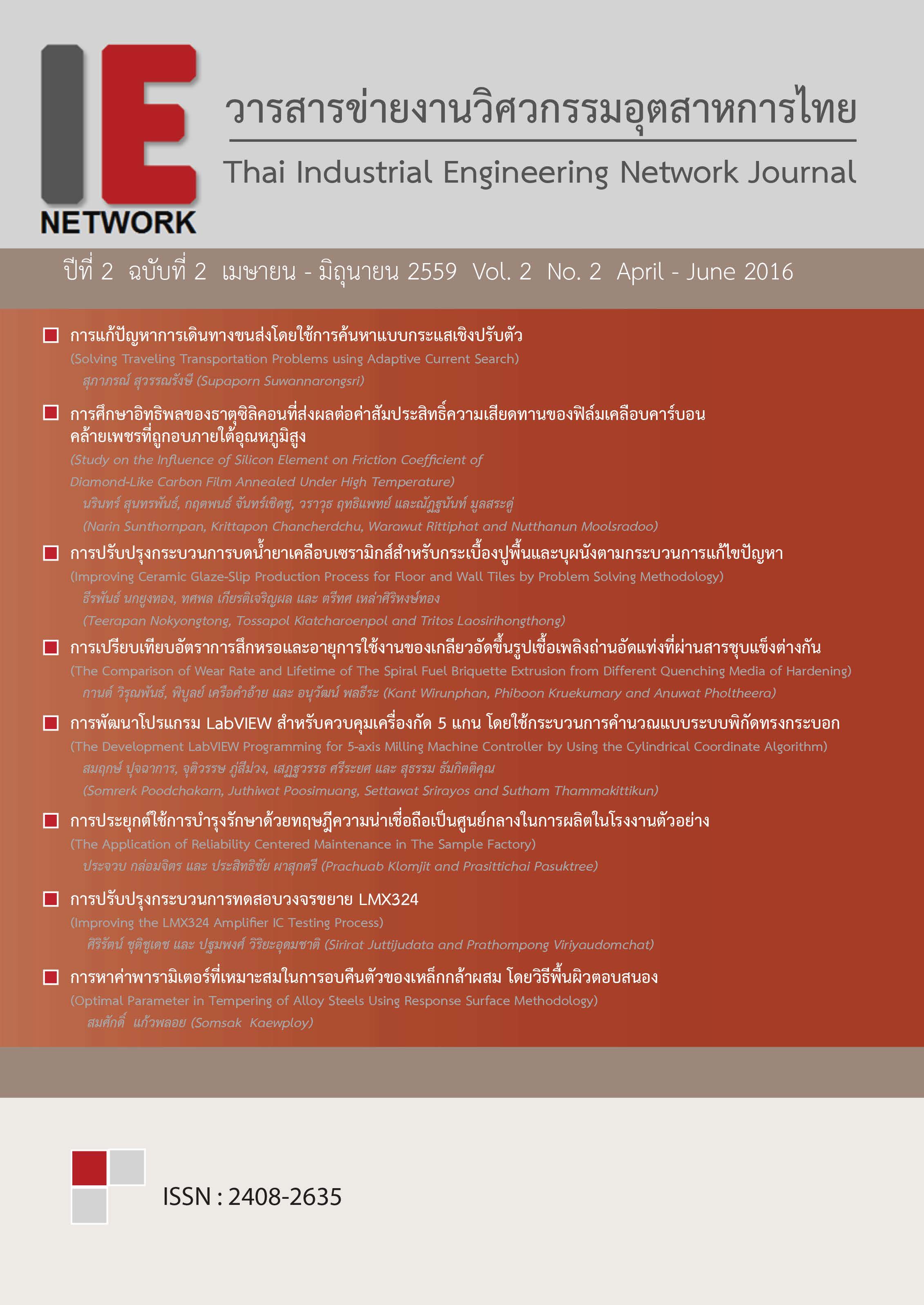The Deverlopment LabVIEW Programming for 5-axis Milling Machine Controller by Using the Cylindrical Coordinate Algorithm
Main Article Content
Abstract
Currently, the CNC 5-axis milling machine are highly used in the domestic production industries. Because of its advantages for reduce a time and labor. The user will always get good quality products, accuracy, precision and acceptable tolerance criteria of size and position, shape and surface roughness from them. The project of this research and development was conducted to design, develop and manufacture the 5- axis milling machine. The main work consisted of 2 parts, 1) Manufacturing a mechanism of the 4th and 5th axis which it has a rotation about x and z axis, respectively. 2) The development LabVIEW Programming for controlling the motion
of a milling cutter to operate a metal removal process with 5 axis, simultaneously. The algorithm used for controlling the motion was developed form Denavit-Hartenberg convention. Thereby the 4th and 5th axes will be a co-operation with the cylindrical coordinate (R, , Z) of a work piece. The main criteria of the cutting process was the rotational axis of the cutting tool must be a right angle with the finished surface of work piece. The systematic approach of this criteria was a comparison onto Z axis between the cutting point and the next point of milling router must be a closeness value by a defined tolerance. The results of an iterative computation will give the all of 5 axes motion variables (X, Y, Z, 1, 2). The experimental results from the test ran of CNC 5-
axis. It could be milling a sandglass geometry-foam material which had the diameter of 40 mm and length of 40 mm of a cylindrical dimension. The cutting tool had a router path followed by the motion control-variables set. The average true percent error of the diameter on a curve of sandglass work piece about 2%
Article Details
บทความ ข้อมูล เนื้อหา รูปภาพ ฯลฯ ที่ได้รับการตีพิมพ์ในวารสารฯ ถือเป็นลิขสิทธิ์ของวารสารฯ หากบุคคลหรือหน่วยงานใดต้องการนำทั้งหมดหรือส่วนหนึ่งส่วนใดไปเผยแพร่ต่อหรือเพื่อกระทำการใดๆ จะได้รับอนุญาต แต่ห้ามนำไปใช้เพื่่อประโยชน์ทางธุรกิจ และห้ามดัดแปลง
References
[2] สมฤกษ์ ปุจฉาการ, ชาติชาย วิเชียรรัตน์,ปิยวัฒน์ หนองประทุม, สุธรรม ธัมกิตติคุณ. การพัฒนาซอฟท์แวร์ควบคุมเครื่องกัด 3 แกนด้วยโปรแกรม LabVIEW เพื่อรองรับรหัสคำสั่ง GCode. การประชุมวิชาการข่ายงานวิศวกรรมอุตสา
หการ ประจำปี 2556; วันที่ 16-18 ตุลาคม 2556, พัทยา, ชลบุรี
[3] Alan Overby. CNC Machining Handbook. McGraw Hill Professional; 2010.
[4] Robert Bishop. LabVIEW 7 Express student edition. Prentice Hall; 2003.
[5] A.H. Slocum. 1992. Precision Machine Design. Englewood Cliffs. Prentice-Hall. NJ; 1992.
[6] Denavit, Jacques; Hartenberg, Richard Scheunemann. A kinematic notation for lower-pair mechanisms based on matrices. 1955; Trans ASME J. Appl. Mech 23: 215–221.
[7] Yitao Duan, Pete Retondo, Robert Hillaire. Three Axis Milling Machine. ME230 Final Project. Fall 1998. University of California at Berkeley. Mechanical Engineering.
[8] Dehong Huo, Kai Cheng, Frank Wardle. Design of a 5-Axis Ultraprecision Micro Milling Machine–UltraMill: Part 1. Holistic Design Approach, Design Considerations, and Specifications. The International Journal of Advanced Manufacturing Technology April 2010; Volume 47, Issue 9-12, pp 867-877.
[9] M. Munlin, S.S. Makhanov, E.L.J. Bohez. Optimization of rotations of a five-axis milling Machine near stationary points. 2004; Computer-Aided Design 36: 1117–1128.
[10] [อินเทอร์เนต]. 2557 [เข้าถึงเมื่อ 17 มีนาคม 2557]. เข้าถึงได้จาก: http://www.mscsoftware.com/
[11] [อินเทอร์เนต]. 2557 [เข้าถึงเมื่อ 22 มีนาคม 2557]. เข้าถึงได้จาก: http://www.wolfram.com/mathematica/
[12] [อินเทอร์เนต]. 2557 [เข้าถึงเมื่อ 27 มีนาคม 2557]. เข้าถึงได้จาก: http://www.ni.com/labview/


